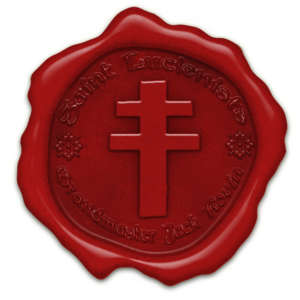Order of Saint Lucien
| ||||||||||||||||||||||||||
The Poor-Fellow Soldiers of Horen and Saint Lucien of Savoie (Flexio: Pauperes commilitones Horeni et Sanctus Lucianus), was a Lucienist military order formed by High Pontiff Lucien II of the Church of the True Faith. Formed through a papal bull, the Order was active between 1447-1459.
During the height of its power, the Order of Saint Lucien acted as an overall force for the Church of the True Faith, often guarding clergymen and participating in wars against non-humans. They enjoyed a great deal of success in expanding the Church's influence to the various Elven dominions, and spent much time fighting the minions of Setherien throughout Anthos. The Order was not without its human enemies, often finding themselves in brawls with followers of the Raevir Orthodoxy. This would eventually lead to the Order's disbandment in 1459 in the Proclamation of Demilitarization after the theses of Basil of Sabris and Simon of Khazav to dissolve the Church started gaining popular attention.
Contents
History
Rise
Before they were known as a holy order, they first went by the name of the Vandorian Order. They were a group of mercenaries who participated in a few skirmishes, before being known as the Order of Saint Lucien, who are the first military body that has sworn itself directly to the Church of the True Faith, swearing under the then High Pontiff Lucien II. They were known for a few more names such as The Poor-Fellow Soldiers of Horen and the Temple of Ard Krallackh, although less commonly used than the Order of Saint Lucien. Their goals are to exterminate unholy beings, criminals, heretics, and enemies of the church. They worship the True Faith of the Humans, dedicating themselves to Saint Lucien of Savoie, styling themselves as Lucienists. They are the only holy order to give clemency, that they found to baptize their fallen foes who are willing to repent, for a way out of the eternal punishment in human dogma. The Order of Saint Lucien was eventually disbanded when the church nulled its vows, effectively disbanding them. A majority of its ordermen went on to join other Imperial Orders, and later founded Aesterwald.
The Order of Saint Lucien was active in many battles, the following is documented proof of their participation over the years.
Decline
TBC
Dissolution
TBC
Organization
The Order of Saint Lucien was organized as a monastic order and wielded considerable influence throughout Anthos and the Fringe because of its numerous holdings scattered about multiple countries. The most basic forts and lodgings were referred to as Bailiwicks, which often held anywhere from five to fifty men. Each bailiwick was appointed a titular bailiff to oversee the institution. After a group of bailiwicks had been installed in an area, one would be chosen for expansion. This resulted in the creation of a commandery, which would be run by a Master-and-Commander, who would further control the local bailiffs. Each Master-and-Commander reported periodically to the Grand Master. Each commandery was then placed under a religious jurisdiction known as a priory, which would be overseen by a prior sent by the High Pontiff. While Master-and-Commanders held most of the authority in the day-to-day operations of their soldiers, Priors often held administrative dominance.
The primary commander of the Order of Saint Lucien was located in the Black Marsh, a particularly cold swamp that separated Abresi from the northern Kingdom of Herendul. While most of the knowledge regarding Lucienist information was lost in the flood of Anthos, it is commonly known that there was a baliwick established on the ruins of Kaedrin in the Westerlands, and a commandery placed upon the ruins of the Old Cloud Temple.
Ranks
The ranking structure of the Order of Saint Lucien was split into three categories: High Command, Low Command, and Enlisted Men. High Command consisted exclusively of the Grand Master's chosen advisors, known as the Inner Council of Bailiffs, of whom were required to be Knights of Justice. The main advisor to the Grandmaster was known as the Grand Commander, and acted oftentimes as the face of the order. The Grand Chancellor was responsible for handling most of the administrative paperwork throughout the order, as well as acting as a public liaison. The Grand Prior, appointed by the High Pontiff, handled most of the Order's interior religious efforts. The Grand Conservator handled all logistical works throughout the order, handling all means of income and expense and equipment allocation.
The Low Command consisted of all of the knights of the order who were not in the Inner Council. There were three types of Lucienist Knights: Knights of Justice, Knights of Obedience, and Knights of Devotion. Knights of Justice were considered to be the most pious of their counterparts, taking up vows to chastity, poverty, and obedience. They adorned a red cloak upon their white mantle to signify the devotion of their life to God. Knights of Obedience were not as pious as the Knights of Justice, as they were only required to take a vow of poverty and obedience. Furthermore, Knights of Devotion only took a vow of poverty, and were often restricted to landed lords who worked part-time with the order. Both Knights of Obedience and Devotion wore grey cloaks. From this body of knights rose two officers, the Knight Commander and Knight Constable; the former of which acted strictly as a direct authority of the knights and the latter of which as his assistant.
The Enlisted Men consisted of three subunits: the Sergeants, the Brothers, and the Initiates. Sergeants were often the grizzled veterans who had worked their way to become non-commissioned officers over their counterparts. A Sergeant-at-Arms was promoted from them to be the lead enlisted man. Brothers referred to general members of the order, but was often used as a catch-all phrase for everyone in the order. Initiates were those who had not taken vows to become full-fledged members of the order.
Holdings
Legacy
...

